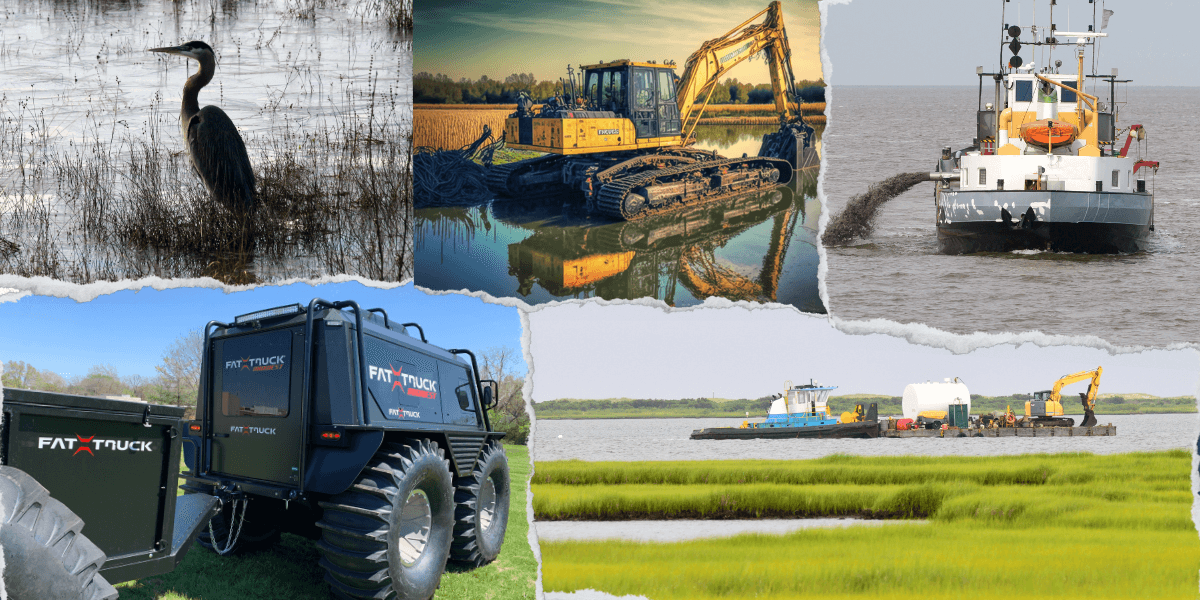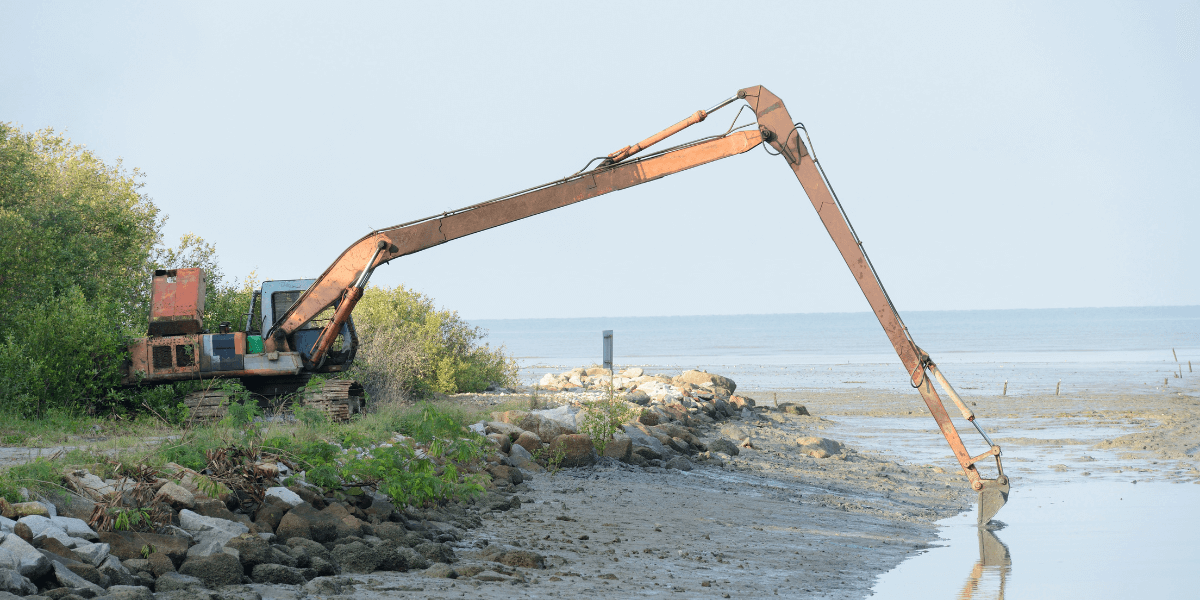Exploring the Versatility of Amphibious Equipment
Dredging and wetland restoration often present unique challenges, especially when dealing with unstable terrain, shifting water levels, and remote...
4 min read
U.S. Aqua Services Oct 30, 2025 12:47:04 PM
.png)
When your worksite sits somewhere between land and water, standard construction gear simply won’t do the job. That’s where amphibious equipment comes in, engineered to tackle mud, marsh, and shallow water with unmatched stability and traction.
In this guide, we’ll break down the most common types of amphibious equipment, including the Fat-Truck, marsh buggy, and amphibious excavator, and help you decide which is best suited for your terrain, budget, and project goals.
You’ll also find a quick-reference terrain matrix, a rental readiness checklist, and real-world examples of how teams use amphibious platforms effectively across industries.
What is Amphibious Equipment and Why Does it Matter for Wetland or Soft-Ground Projects?
Where Can You Rent Fat-Truck and Other Amphibious Equipment?
Amphibious equipment refers to machines designed to operate seamlessly on both land and water, providing traction and flotation in soft, swampy, or flooded conditions.
These machines matter because they keep projects moving where standard construction or transport vehicles would sink, stall, or damage the environment.
Amphibious platforms are widely used in:
Wetland restoration and dredging projects
Pipeline and utility access through marshlands
Emergency response in flooded zones
Environmental surveys and shoreline stabilization
By using the right equipment, crews can complete work efficiently while minimizing environmental impact — a crucial advantage in coastal and marsh environments.
There are three main types of amphibious equipment commonly used in industrial, environmental, and restoration work: Fat-Trucks, marsh buggies, and amphibious excavators.
A Fat-Truck is a compact, amphibious, all-terrain vehicle that can travel across mud, snow, sand, and water. It can carry up to eight passengers, float effortlessly, and climb steep inclines.
Ideal for: Personnel transport, light cargo, and inspection routes
Advantages: Quick deployment, low ground pressure, and minimal environmental disturbance
A marsh buggy, also known as an amphibious carrier, features pontoons and tracks for flotation and stability on extremely soft terrain.
Ideal for: Material transport, marsh restoration, and pipeline logistics
Advantages: High payload capacity and excellent traction
An amphibious excavator combines traditional excavation power with floating pontoons for dredging or digging in shallow water.
Ideal for: Dredging, sediment removal, and coastal restoration
Advantages: Stability, reach, and digging precision in semi-submerged conditions
Choosing the right platform depends on ground conditions, project scope, and water depth. The following terrain matrix outlines how each performs across common environments:
| Terrain Type | Fat-Truck | Marsh Buggy | Amphibious Excavator |
|---|---|---|---|
Mud/Soft Ground |
Excellent traction |
Excellent mobility |
Stable for digging |
Marsh/Wetland |
Low impact |
Superior flotation |
Good stability |
Shallow Water/Tidal Flats |
Float-capable |
Ideal for semi-submerged work |
Designed for excavation |
Flooded Areas |
Rapid deployment |
Moderate |
Highly effective |
Dry Ground |
Efficient travel |
Limited |
Stationary use only |
Quick takeaway:
Use a Fat-Truck for transport and access.
Use a marsh buggy for material movement and mobility.
Use an amphibious excavator for digging, dredging, and restoration.
Before scheduling an amphibious equipment rental, it’s essential to plan for logistics, compliance, and crew readiness.
Verify access routes for heavy transport and off-loading.
Schedule mobilization according to tide cycles and soil conditions.
Confirm whether you need cranes or barges for delivery.
Secure environmental or wetland permits in advance.
Verify compliance with state and federal regulations (e.g., Clean Water Act).
Require certified operators familiar with flotation dynamics.
Conduct safety briefings on water entry and emergency retrieval procedures.
Confirm insurance coverage for both land and water operations.
Include environmental cleanup and recovery protection if applicable.
By completing these checks, you reduce risks, avoid fines, and ensure your project runs smoothly from mobilization to demobilization.
Real-world applications show how each machine supports efficiency and safety across industries.
Crews rely on marsh buggies for transporting materials and Fat-Trucks for carrying personnel safely through wetlands.
Best combo: Fat-Truck + Marsh Buggy
Projects use amphibious excavators to dig channels or clear sediment, while Fat-Trucks handle crew and tool transport.
Best combo: Amphibious Excavator + Fat-Truck
Amphibious excavators perform dredging or sediment work while marsh buggies manage material logistics.
Best combo: Amphibious Excavator + Marsh Buggy
These pairings help teams save time, improve safety, and minimize damage to delicate wetland ecosystems.
You can rent Fat-Trucks, marsh buggies, and amphibious excavators directly through U.S. Aqua Services, which provides turnkey mobilization, certified operators, and maintenance support.
Whether your site involves tidal flats, riverbanks, or soft marsh terrain, our rental fleet is engineered to perform reliably in all conditions.
👉 Check availability / Request Fat-Truck rental to get pricing or reserve equipment for your upcoming project.
It means the equipment can operate on both land and water, using pontoons or sealed tires for flotation.
Renting provides access to modern, well-maintained machines without long-term maintenance or storage costs.
Most models operate efficiently in up to 6 feet of water, depending on boom length and pontoon design.
Yes. Fat-Trucks are designed with rollover protection, seat belts, and buoyant chambers to keep occupants safe on any terrain.
Oil & gas, environmental restoration, construction, and utility maintenance commonly rely on these platforms.
Operators should be trained on amphibious systems and flotation dynamics; professional certification is strongly recommended.
Use the terrain matrix above or contact U.S. Aqua Services for a site-specific equipment match.
U.S. Aqua Services was created to support the dredging process in advancing commerce and responding to its many challenges. To accomplish this, our dredging company assembled an exceptional group of experienced individuals and a diverse inventory of dredge equipment.
We offer dredging equipment rental services so you can have access to the latest and greatest in dredging technology without having to pay to maintain it, transport, and store it, along with dewatering services.
With an emphasis on mobility, dependability, durability, diversity, efficiency, and safety, our dredging rental company can ensure that our different types of dredging systems are easy to move through any terrain and can work in the most rugged and remote environments. Our multi-function hydraulic systems are built with jetting and mechanical options that can efficiently move loose sediment or stiff layers of clay.
US Aqua services also and maintains a ready fleet of amphibious equipment capable of completing dredging projects in some of the harshest and most remote environments. U.S Aqua is also the dealer for Louisiana of the amphibious vehicle Fat Truck. No matter the size or scope of the job or the remoteness of your work location, you can rely on Fat Truck’s industrial off-road utility vehicles to get the job done right.

Dredging and wetland restoration often present unique challenges, especially when dealing with unstable terrain, shifting water levels, and remote...

Wetlands are some of the planet's most delicate and ecologically valuable environments. Whether for conservation, restoration, or infrastructure...
Amphibious vehicles, once primarily for military use, now play vital roles in engineering, dredging, and mining, offering efficient transport...